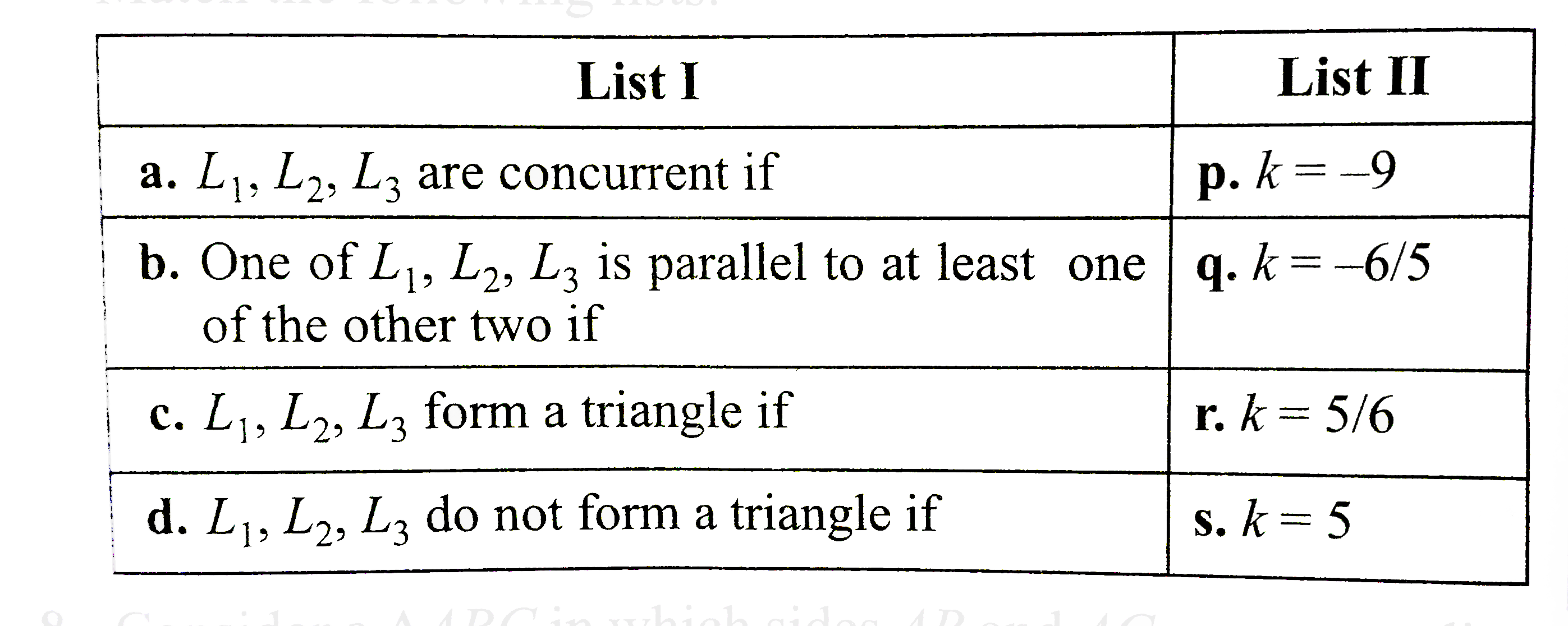If the lines L1:2x−3y−6=0,L2:x+y−4=0 and L3:x+2 and tanA,tanB and tanC are the roots of the equation ax3+bx2+cx−15=0 then a=3 (b) b=−15 c=28 (d) a+b+c=15
To solve the problem, we need to analyze the given lines and their slopes, find the angles between them, and then relate those angles to the roots of the polynomial equation. Here’s a step-by-step breakdown of the solution:
Step 1: Find the slopes of the lines
1. Line L1: The equation is 2x−3y−6=0. Rearranging gives us:
3y=2x−6⟹y=23x−2
The slope m1 of line L1 is 23.
2. Line L2: The equation is x+y−4=0. Rearranging gives us:
y=−x+4
The slope m2 of line L2 is −1.
3. Line L3: The equation is x+2=0, which is a vertical line. The slope m3 is undefined.
Step 2: Find the angles between the lines
The angles A, B, and C correspond to the slopes of the lines. We can find the tangent of the angles using the formula:
tanA=m1−m21+m1m2
Substituting m1=23 and m2=−1:
tanA=23−(−1)1+23⋅(−1)=23+11−23=23+3313=5313=5
Step 3: Find the tangent of angle C
Since line L3 is vertical, it makes a right angle with the horizontal axis. Thus, the angle C is 90∘ minus the angle corresponding to line L1. The tangent of angle C can be determined using the cotangent:
tanC=1tan(90∘−θ)=1tanA=15
Step 4: Write the polynomial equation
The roots of the polynomial ax3+bx2+cx−15=0 are given as tanA, tanB, and tanC. We have:
- tanA=5
- tanB=1 (since B corresponds to the angle of line L2, which is 45∘)
- tanC=32 (from the vertical line L3)
Step 5: Use Vieta's formulas
Using Vieta's formulas, we know:
1. The sum of the roots:
tanA+tanB+tanC=−ba
Substituting the values:
5+1+32=−ba
This gives:
6.5=−ba⟹b=−6.5a
2. The product of the roots:
tanA⋅tanB⋅tanC=−ca
Substituting the values:
5⋅1⋅32=−ca⟹152=−ca⟹c=−152a
Step 6: Solve for a, b, and c
Given a=3:
1. b=−6.5⋅3=−19.5
2. c=−152⋅3=−22.5
Step 7: Check the options
1. a+b+c=3−19.5−22.5=−39, which does not equal 15.
2. The values of a, b, and c do not satisfy the conditions given in the options.
Final Answer
The only option that holds true is:
- a+b+c=15 is incorrect.
- The values of a, b, and c do not match the given options.
1. Line L1: The equation is 2x−3y−6=0. Rearranging gives us:
3y=2x−6⟹y=23x−2
The slope m1 of line L1 is 23.
y=−x+4
The slope m2 of line L2 is −1.
The angles A, B, and C correspond to the slopes of the lines. We can find the tangent of the angles using the formula:
tanA=m1−m21+m1m2
Substituting m1=23 and m2=−1:
tanA=23−(−1)1+23⋅(−1)=23+11−23=23+3313=5313=5
Since line L3 is vertical, it makes a right angle with the horizontal axis. Thus, the angle C is 90∘ minus the angle corresponding to line L1. The tangent of angle C can be determined using the cotangent:
tanC=1tan(90∘−θ)=1tanA=15
The roots of the polynomial ax3+bx2+cx−15=0 are given as tanA, tanB, and tanC. We have:
- tanA=5
- tanB=1 (since B corresponds to the angle of line L2, which is 45∘)
- tanC=32 (from the vertical line L3)
Using Vieta's formulas, we know:
1. The sum of the roots:
tanA+tanB+tanC=−ba
Substituting the values:
5+1+32=−ba
This gives:
6.5=−ba⟹b=−6.5a
tanA⋅tanB⋅tanC=−ca
Substituting the values:
5⋅1⋅32=−ca⟹152=−ca⟹c=−152a
Given a=3:
1. b=−6.5⋅3=−19.5
2. c=−152⋅3=−22.5
1. a+b+c=3−19.5−22.5=−39, which does not equal 15.
2. The values of a, b, and c do not satisfy the conditions given in the options.
The only option that holds true is:
- a+b+c=15 is incorrect.
- The values of a, b, and c do not match the given options.
Topper's Solved these Questions
Similar Questions
If a+b+c=0 then check the nature of roots of the equation 4ax2+3bx+2c=0wherea,b,c∈R.
View SolutionIf a,b and c are the roots of the equation x3+2x2+1=0, find ∣∣ ∣∣abcbcacab∣∣ ∣∣.
View SolutionIf a,b and c are the roots of the equation x3+2x2+1=0, find ∣∣ ∣∣abcbcacab∣∣ ∣∣.
View SolutionConsider the lines given by
L1:x+3y−5=0
L2:3x−ky−1=0
L3:5x+2y−12=0
Match the following lists.

View SolutionNumber of roots of equation 3|x|−|2−|x∣∣=1 is a. 0 b. 2 c. 4 d. 7
View SolutionNumber of roots of equation 3|x|−|2−|x∣∣=1 is a. 0 b. 2 c. 4 d. 7
View SolutionIf l,m,n are the three positive roots of the equation x3−ax2+bx−48=0, then the minimum value of (1/l)+(2/m)+(3/n) equals a1 b2 c32 d52
View SolutionIf one root of the equation 2x2+bx+c=0 is three times the other, then b2:ac=
(a)3:1 (b) 3:16 (c) 16:3 (d) 16:1
View SolutionIf the lines x+ay+a=0, bx+y+b=0 and cx+cy+1=0 are concurrent, then write the value of 2abc−ab−bc−ca.
View SolutionIf the circle x2+y2+2x+3y+1=0 cuts x2+y2+4x+3y+2=0 at AandB , then find the equation of the circle on AB as diameter.
View Solution
